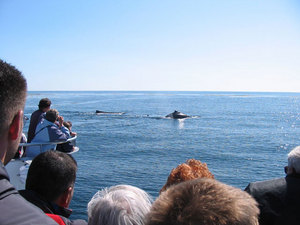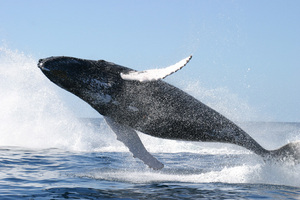The largest animals that ever lived, with brains larger than humans, whales were land beasts that, eons ago, returned to the ocean. From Bar Harbor all the way down the coast of Maine, whales can be seen cruising and frolicking throughout the summer. Six whale species can be seen along Maine’s coast: three great whites — the Finback, the Humpback and the Minke; the North Atlantic Right Whale and the Pilot whale; and, less often seen, Orca (killer whales). Seals, dolphins, porpoises and puffins often frolic with the whales.
When to See Whales In Maine: In mid-April, the whales arrive, cruising the coast until October, when they leave for warmer waters. The best time of year to see whales in Maine is June, July and the beginning of August. While whales can be spotted any time of day, at midday they tend to become scarcer as they dive deeper to feed. Depending on the species, whales can eat from 2,625 to 4,400 pounds of fish or plankton a day.
How and Where to See Whales In Maine: Good whale-spotting locations in from land Maine are off Seal Island, Mount Desert Rock, the shoals of Jeffrey’s Ledge, and Matinicus Rock. Whales can also be spotted from shore at the West Quoddy Head and Bass Harbor lighthouses, and some coastal B&Bs; offer whale watching from their balconies. The most popular way to spot whales is to take a whale-watching cruise, which is a booming business in Bar Harbor and down the coast of Maine.
Whale Behavior: Baby whales nurse for six to seven months, and can often be sighted swimming alongside their mothers. Activities called “whale play” delight onlookers and include Tail Slapping (slapping tail on top of the water), Lobe Tailing (thrusting lower body out of the water), Spy Hopping (peeking their heads up) and Breaching (jumping completely out of the water). It is common to see whales spouting water through their blowholes, providing memorable photo opportunities.
A fascinating sight is to see the whales “bubble net feeding,” where they rise as a group to create an upwelling, sending schools of fish into the “bubble net,” a “cage” of air that traps fish. The whales then rise up open-mouthed to swallow the whole “cage.”
How to identify Maine Whales
Humpback Whales are referred to as the “Clowns of the Sea” for their penchant for whale play. They range from 30 to 60 feet long, can weigh 40 tons, and have long, white pectoral fins. The tails, referred to as “flukes,” identify individual whales by the markings specific to each whale. Bumps can be found on their snouts and along the edges of their flippers. Humpbacks are so used to the watchers that they sometimes swim right up to the boat..
Finback Whales are black on the left side of the jaw, white on the right. Finbacks are the second largest whales in the world, weighting up 80 tons, and can grow to 80 feet long. Individual features include a tall “blow hole” (spout).
The endangered North Atlantic Right Whales (there are only 350 to 400 left in the world) got their name because they were considered the best (“right”) whale to hunt — they were very approachable and floated when killed. They range from 20 to 50 feet long, and can weigh 50 tons. Their double blowhole is often “V” shaped. The Right whale can be identified by its lack of a dorsal fin, and the whitish bumps called callosities on its head. Whale-watchers are forbidden to get with in 500 yards of a North Atlantic Right Whale.
Minke Whales are smaller and often overlooked, but are quite abundant. Minke whales range from 15 to 30 feet long, and can weigh six to eight tons. Minke whales have no teeth, but, instead, a unique food-filtering jaw. Minkes are dark gray above, and light gray below, may have stripes behind the flippers on top, and on each flipper is a characteristic white band. Minke whales like to face the boats with their pointed snouts out of the water.
Pilot Whales are members of the dolphin family, and the two species of this whale are differentiated by either long or short fins. Pilots are small, slender-toothed, with bulging foreheads and a beak-like snout, with slender pointed flippers. They range from 13 to 20 feet long and weigh three to four tons. Pilot Whales are known to “mass strand.”
Orca (Killer) Whales are medium sized whales, between 18 to 30 feet long, and their average weight is nine tons. Known for their powerful jaws and strong tightly fit teeth, Orcas eat other animals. Orcas have four fins, and their sharp dorsal fin is the longest of any whale, reaching as far as six feet.
Whale Watching Guidelines
Never restrict the movement or behavior of a whale, or attempt to make contact or spur a reaction from them. Whale play can endanger your vessel, so do not approach within 100 feet. If a whale approaches your vessel, go into neutral gear, and don’t start your propeller until the whale surfaces and is clear of the vessel. Never get between a mother and a calf. It is not advisable to dive in the vicinity of a whale; divers should never get with 100 feet of a whale.
Excessive speed should be avoided within a quarter mile of a whale. At 300 feet, a whale can be approached, but only at idle speed; never approach a moving or resting whale head-on. Stay away from light-green bubble patches, as that is a whale preparing to rise to the surface with its prey.
SOURCES: The Easy Traveler;Whale Center of New England; Whales and whale watching; The North Atlantic Right Whale; Humpback Whales; Minke Whales; Fin Whales; Pilot Whales; Orca (Killer) Whales; Whale Watching Charters




